Property Law Assignment
VerifiedAdded on 2019/11/19
|8
|2001
|278
Report
AI Summary
This legal report examines the impact of substantial property damage on contracts for the sale of land in New South Wales, Australia. It focuses on Section 66J(2) of the Conveyancing Act 1919, which addresses situations where damage renders the property materially different from what was contracted. The report analyzes two key cases: *Bakhos v Fenner & Anor* [2007] NSWSC 641 and *Urban House v Purnell Bros* [2007] NSWSC 1248. *Bakhos v Fenner* illustrates a scenario where damage was deemed insufficient to rescind the contract, emphasizing factors like the property's pre-existing condition, the repairability of the damage, and the buyer's intentions. Conversely, *Urban House v Purnell Bros* highlights a situation where fire damage rendered the property untenantable, justifying contract rescission. The report concludes that courts consider various factors, including the extent of damage, the property's condition before the damage, and the parties' intentions, when determining whether damage is 'substantial' enough to warrant contract rescission. The website provides past papers and solved assignments to help students understand these complex legal concepts.

Paraphrase This Document
Need a fresh take? Get an instant paraphrase of this document with our AI Paraphraser
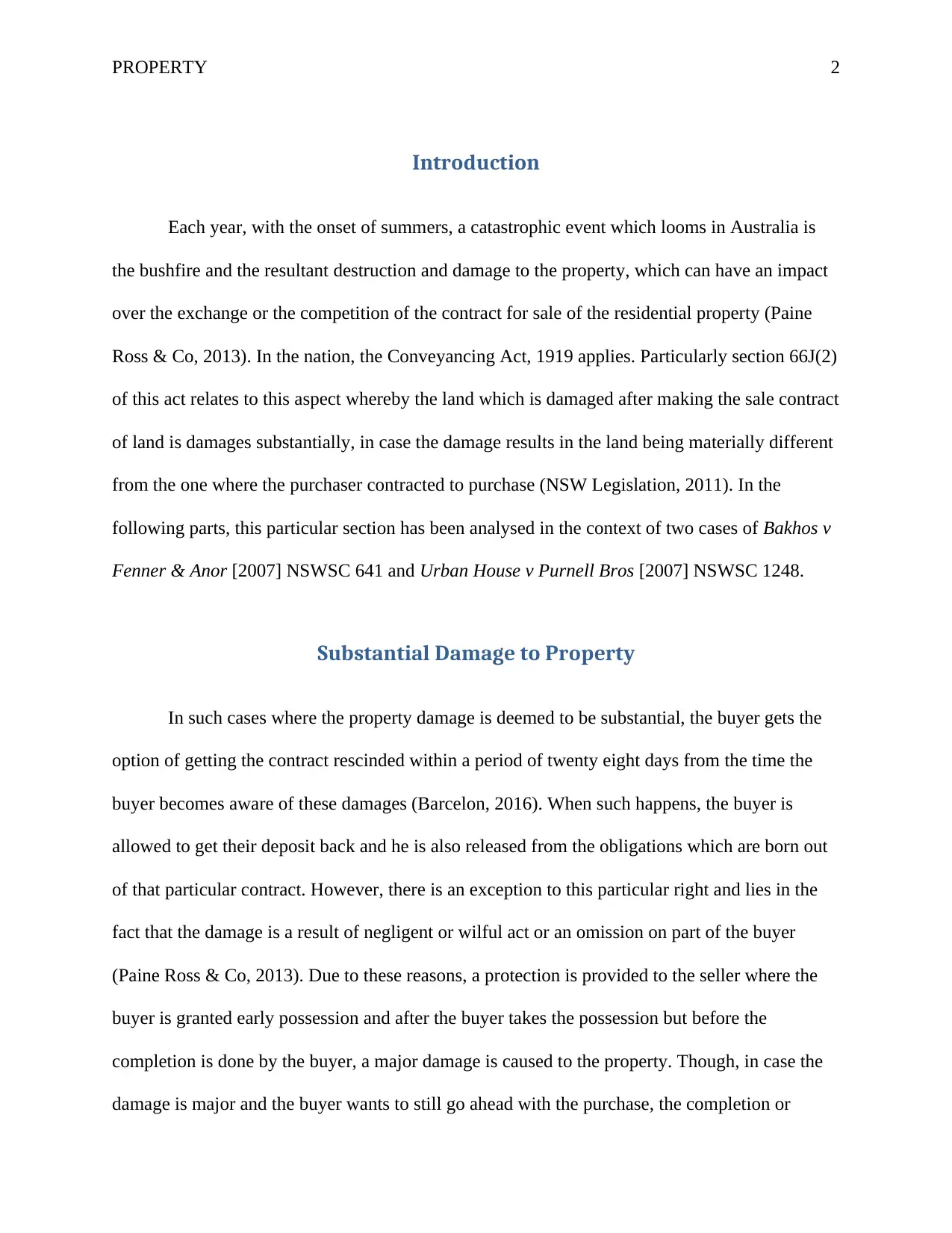
PROPERTY 2
Introduction
Each year, with the onset of summers, a catastrophic event which looms in Australia is
the bushfire and the resultant destruction and damage to the property, which can have an impact
over the exchange or the competition of the contract for sale of the residential property (Paine
Ross & Co, 2013). In the nation, the Conveyancing Act, 1919 applies. Particularly section 66J(2)
of this act relates to this aspect whereby the land which is damaged after making the sale contract
of land is damages substantially, in case the damage results in the land being materially different
from the one where the purchaser contracted to purchase (NSW Legislation, 2011). In the
following parts, this particular section has been analysed in the context of two cases of Bakhos v
Fenner & Anor [2007] NSWSC 641 and Urban House v Purnell Bros [2007] NSWSC 1248.
Substantial Damage to Property
In such cases where the property damage is deemed to be substantial, the buyer gets the
option of getting the contract rescinded within a period of twenty eight days from the time the
buyer becomes aware of these damages (Barcelon, 2016). When such happens, the buyer is
allowed to get their deposit back and he is also released from the obligations which are born out
of that particular contract. However, there is an exception to this particular right and lies in the
fact that the damage is a result of negligent or wilful act or an omission on part of the buyer
(Paine Ross & Co, 2013). Due to these reasons, a protection is provided to the seller where the
buyer is granted early possession and after the buyer takes the possession but before the
completion is done by the buyer, a major damage is caused to the property. Though, in case the
damage is major and the buyer wants to still go ahead with the purchase, the completion or
Introduction
Each year, with the onset of summers, a catastrophic event which looms in Australia is
the bushfire and the resultant destruction and damage to the property, which can have an impact
over the exchange or the competition of the contract for sale of the residential property (Paine
Ross & Co, 2013). In the nation, the Conveyancing Act, 1919 applies. Particularly section 66J(2)
of this act relates to this aspect whereby the land which is damaged after making the sale contract
of land is damages substantially, in case the damage results in the land being materially different
from the one where the purchaser contracted to purchase (NSW Legislation, 2011). In the
following parts, this particular section has been analysed in the context of two cases of Bakhos v
Fenner & Anor [2007] NSWSC 641 and Urban House v Purnell Bros [2007] NSWSC 1248.
Substantial Damage to Property
In such cases where the property damage is deemed to be substantial, the buyer gets the
option of getting the contract rescinded within a period of twenty eight days from the time the
buyer becomes aware of these damages (Barcelon, 2016). When such happens, the buyer is
allowed to get their deposit back and he is also released from the obligations which are born out
of that particular contract. However, there is an exception to this particular right and lies in the
fact that the damage is a result of negligent or wilful act or an omission on part of the buyer
(Paine Ross & Co, 2013). Due to these reasons, a protection is provided to the seller where the
buyer is granted early possession and after the buyer takes the possession but before the
completion is done by the buyer, a major damage is caused to the property. Though, in case the
damage is major and the buyer wants to still go ahead with the purchase, the completion or
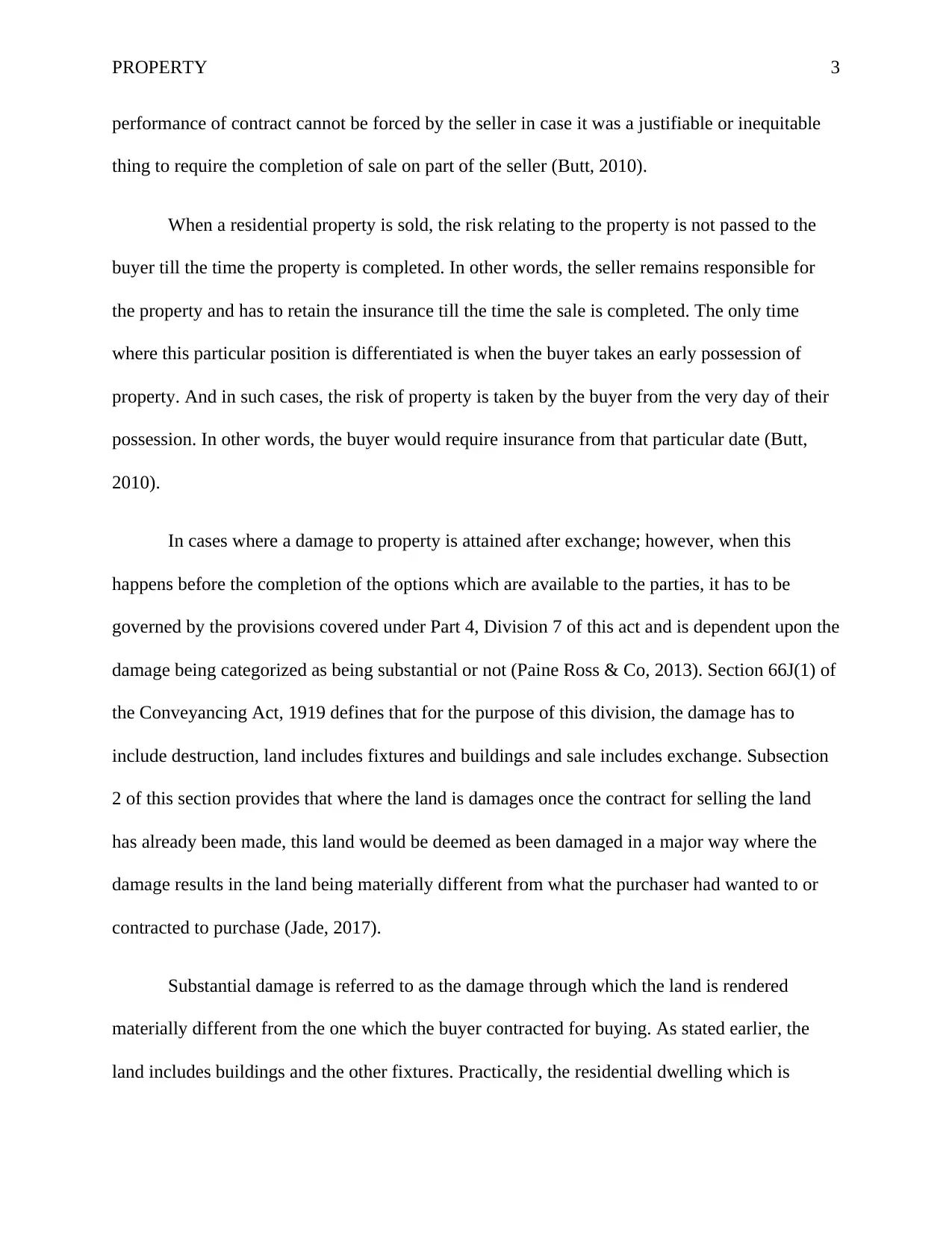
PROPERTY 3
performance of contract cannot be forced by the seller in case it was a justifiable or inequitable
thing to require the completion of sale on part of the seller (Butt, 2010).
When a residential property is sold, the risk relating to the property is not passed to the
buyer till the time the property is completed. In other words, the seller remains responsible for
the property and has to retain the insurance till the time the sale is completed. The only time
where this particular position is differentiated is when the buyer takes an early possession of
property. And in such cases, the risk of property is taken by the buyer from the very day of their
possession. In other words, the buyer would require insurance from that particular date (Butt,
2010).
In cases where a damage to property is attained after exchange; however, when this
happens before the completion of the options which are available to the parties, it has to be
governed by the provisions covered under Part 4, Division 7 of this act and is dependent upon the
damage being categorized as being substantial or not (Paine Ross & Co, 2013). Section 66J(1) of
the Conveyancing Act, 1919 defines that for the purpose of this division, the damage has to
include destruction, land includes fixtures and buildings and sale includes exchange. Subsection
2 of this section provides that where the land is damages once the contract for selling the land
has already been made, this land would be deemed as been damaged in a major way where the
damage results in the land being materially different from what the purchaser had wanted to or
contracted to purchase (Jade, 2017).
Substantial damage is referred to as the damage through which the land is rendered
materially different from the one which the buyer contracted for buying. As stated earlier, the
land includes buildings and the other fixtures. Practically, the residential dwelling which is
performance of contract cannot be forced by the seller in case it was a justifiable or inequitable
thing to require the completion of sale on part of the seller (Butt, 2010).
When a residential property is sold, the risk relating to the property is not passed to the
buyer till the time the property is completed. In other words, the seller remains responsible for
the property and has to retain the insurance till the time the sale is completed. The only time
where this particular position is differentiated is when the buyer takes an early possession of
property. And in such cases, the risk of property is taken by the buyer from the very day of their
possession. In other words, the buyer would require insurance from that particular date (Butt,
2010).
In cases where a damage to property is attained after exchange; however, when this
happens before the completion of the options which are available to the parties, it has to be
governed by the provisions covered under Part 4, Division 7 of this act and is dependent upon the
damage being categorized as being substantial or not (Paine Ross & Co, 2013). Section 66J(1) of
the Conveyancing Act, 1919 defines that for the purpose of this division, the damage has to
include destruction, land includes fixtures and buildings and sale includes exchange. Subsection
2 of this section provides that where the land is damages once the contract for selling the land
has already been made, this land would be deemed as been damaged in a major way where the
damage results in the land being materially different from what the purchaser had wanted to or
contracted to purchase (Jade, 2017).
Substantial damage is referred to as the damage through which the land is rendered
materially different from the one which the buyer contracted for buying. As stated earlier, the
land includes buildings and the other fixtures. Practically, the residential dwelling which is
⊘ This is a preview!⊘
Do you want full access?
Subscribe today to unlock all pages.

Trusted by 1+ million students worldwide
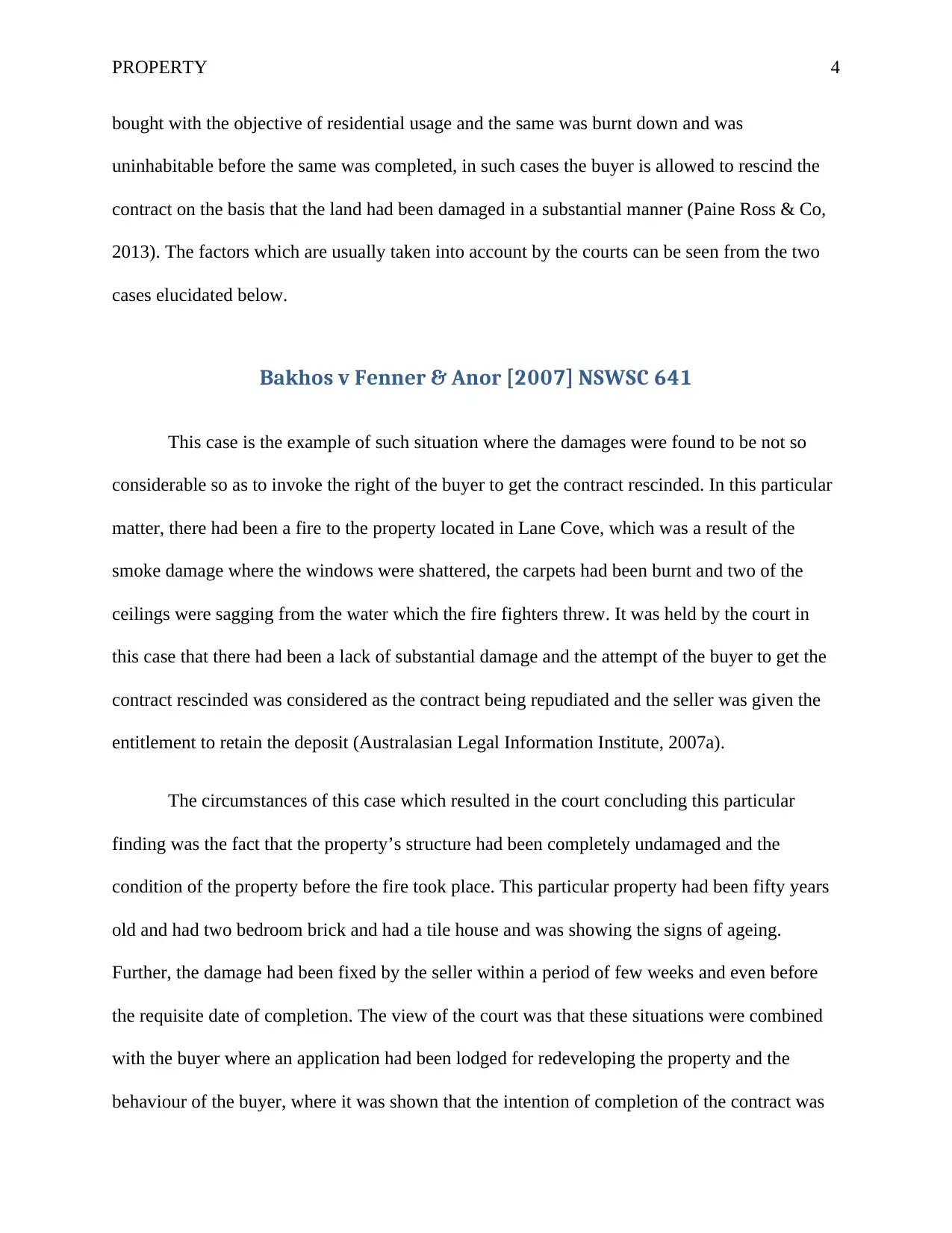
PROPERTY 4
bought with the objective of residential usage and the same was burnt down and was
uninhabitable before the same was completed, in such cases the buyer is allowed to rescind the
contract on the basis that the land had been damaged in a substantial manner (Paine Ross & Co,
2013). The factors which are usually taken into account by the courts can be seen from the two
cases elucidated below.
Bakhos v Fenner & Anor [2007] NSWSC 641
This case is the example of such situation where the damages were found to be not so
considerable so as to invoke the right of the buyer to get the contract rescinded. In this particular
matter, there had been a fire to the property located in Lane Cove, which was a result of the
smoke damage where the windows were shattered, the carpets had been burnt and two of the
ceilings were sagging from the water which the fire fighters threw. It was held by the court in
this case that there had been a lack of substantial damage and the attempt of the buyer to get the
contract rescinded was considered as the contract being repudiated and the seller was given the
entitlement to retain the deposit (Australasian Legal Information Institute, 2007a).
The circumstances of this case which resulted in the court concluding this particular
finding was the fact that the property’s structure had been completely undamaged and the
condition of the property before the fire took place. This particular property had been fifty years
old and had two bedroom brick and had a tile house and was showing the signs of ageing.
Further, the damage had been fixed by the seller within a period of few weeks and even before
the requisite date of completion. The view of the court was that these situations were combined
with the buyer where an application had been lodged for redeveloping the property and the
behaviour of the buyer, where it was shown that the intention of completion of the contract was
bought with the objective of residential usage and the same was burnt down and was
uninhabitable before the same was completed, in such cases the buyer is allowed to rescind the
contract on the basis that the land had been damaged in a substantial manner (Paine Ross & Co,
2013). The factors which are usually taken into account by the courts can be seen from the two
cases elucidated below.
Bakhos v Fenner & Anor [2007] NSWSC 641
This case is the example of such situation where the damages were found to be not so
considerable so as to invoke the right of the buyer to get the contract rescinded. In this particular
matter, there had been a fire to the property located in Lane Cove, which was a result of the
smoke damage where the windows were shattered, the carpets had been burnt and two of the
ceilings were sagging from the water which the fire fighters threw. It was held by the court in
this case that there had been a lack of substantial damage and the attempt of the buyer to get the
contract rescinded was considered as the contract being repudiated and the seller was given the
entitlement to retain the deposit (Australasian Legal Information Institute, 2007a).
The circumstances of this case which resulted in the court concluding this particular
finding was the fact that the property’s structure had been completely undamaged and the
condition of the property before the fire took place. This particular property had been fifty years
old and had two bedroom brick and had a tile house and was showing the signs of ageing.
Further, the damage had been fixed by the seller within a period of few weeks and even before
the requisite date of completion. The view of the court was that these situations were combined
with the buyer where an application had been lodged for redeveloping the property and the
behaviour of the buyer, where it was shown that the intention of completion of the contract was
Paraphrase This Document
Need a fresh take? Get an instant paraphrase of this document with our AI Paraphraser
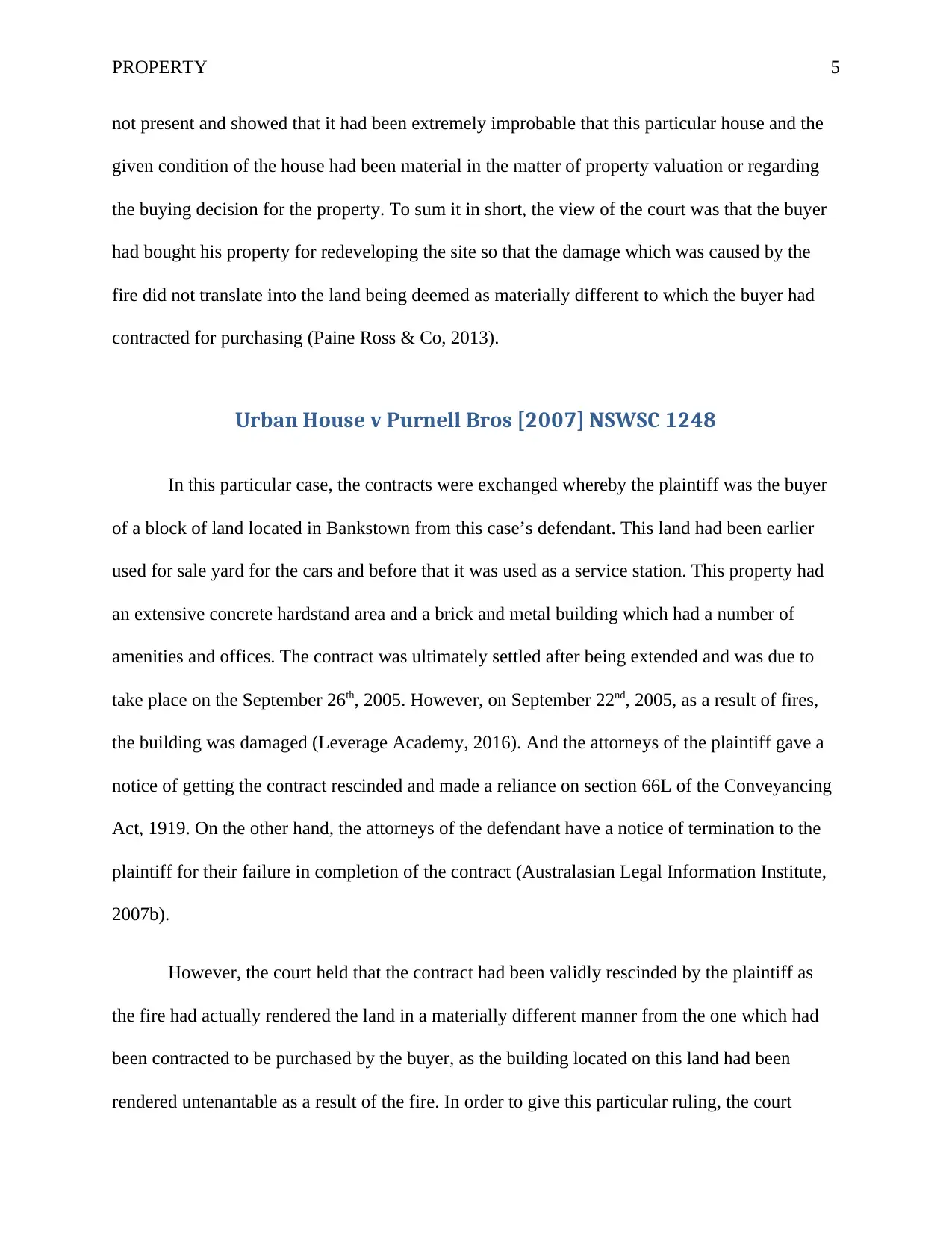
PROPERTY 5
not present and showed that it had been extremely improbable that this particular house and the
given condition of the house had been material in the matter of property valuation or regarding
the buying decision for the property. To sum it in short, the view of the court was that the buyer
had bought his property for redeveloping the site so that the damage which was caused by the
fire did not translate into the land being deemed as materially different to which the buyer had
contracted for purchasing (Paine Ross & Co, 2013).
Urban House v Purnell Bros [2007] NSWSC 1248
In this particular case, the contracts were exchanged whereby the plaintiff was the buyer
of a block of land located in Bankstown from this case’s defendant. This land had been earlier
used for sale yard for the cars and before that it was used as a service station. This property had
an extensive concrete hardstand area and a brick and metal building which had a number of
amenities and offices. The contract was ultimately settled after being extended and was due to
take place on the September 26th, 2005. However, on September 22nd, 2005, as a result of fires,
the building was damaged (Leverage Academy, 2016). And the attorneys of the plaintiff gave a
notice of getting the contract rescinded and made a reliance on section 66L of the Conveyancing
Act, 1919. On the other hand, the attorneys of the defendant have a notice of termination to the
plaintiff for their failure in completion of the contract (Australasian Legal Information Institute,
2007b).
However, the court held that the contract had been validly rescinded by the plaintiff as
the fire had actually rendered the land in a materially different manner from the one which had
been contracted to be purchased by the buyer, as the building located on this land had been
rendered untenantable as a result of the fire. In order to give this particular ruling, the court
not present and showed that it had been extremely improbable that this particular house and the
given condition of the house had been material in the matter of property valuation or regarding
the buying decision for the property. To sum it in short, the view of the court was that the buyer
had bought his property for redeveloping the site so that the damage which was caused by the
fire did not translate into the land being deemed as materially different to which the buyer had
contracted for purchasing (Paine Ross & Co, 2013).
Urban House v Purnell Bros [2007] NSWSC 1248
In this particular case, the contracts were exchanged whereby the plaintiff was the buyer
of a block of land located in Bankstown from this case’s defendant. This land had been earlier
used for sale yard for the cars and before that it was used as a service station. This property had
an extensive concrete hardstand area and a brick and metal building which had a number of
amenities and offices. The contract was ultimately settled after being extended and was due to
take place on the September 26th, 2005. However, on September 22nd, 2005, as a result of fires,
the building was damaged (Leverage Academy, 2016). And the attorneys of the plaintiff gave a
notice of getting the contract rescinded and made a reliance on section 66L of the Conveyancing
Act, 1919. On the other hand, the attorneys of the defendant have a notice of termination to the
plaintiff for their failure in completion of the contract (Australasian Legal Information Institute,
2007b).
However, the court held that the contract had been validly rescinded by the plaintiff as
the fire had actually rendered the land in a materially different manner from the one which had
been contracted to be purchased by the buyer, as the building located on this land had been
rendered untenantable as a result of the fire. In order to give this particular ruling, the court
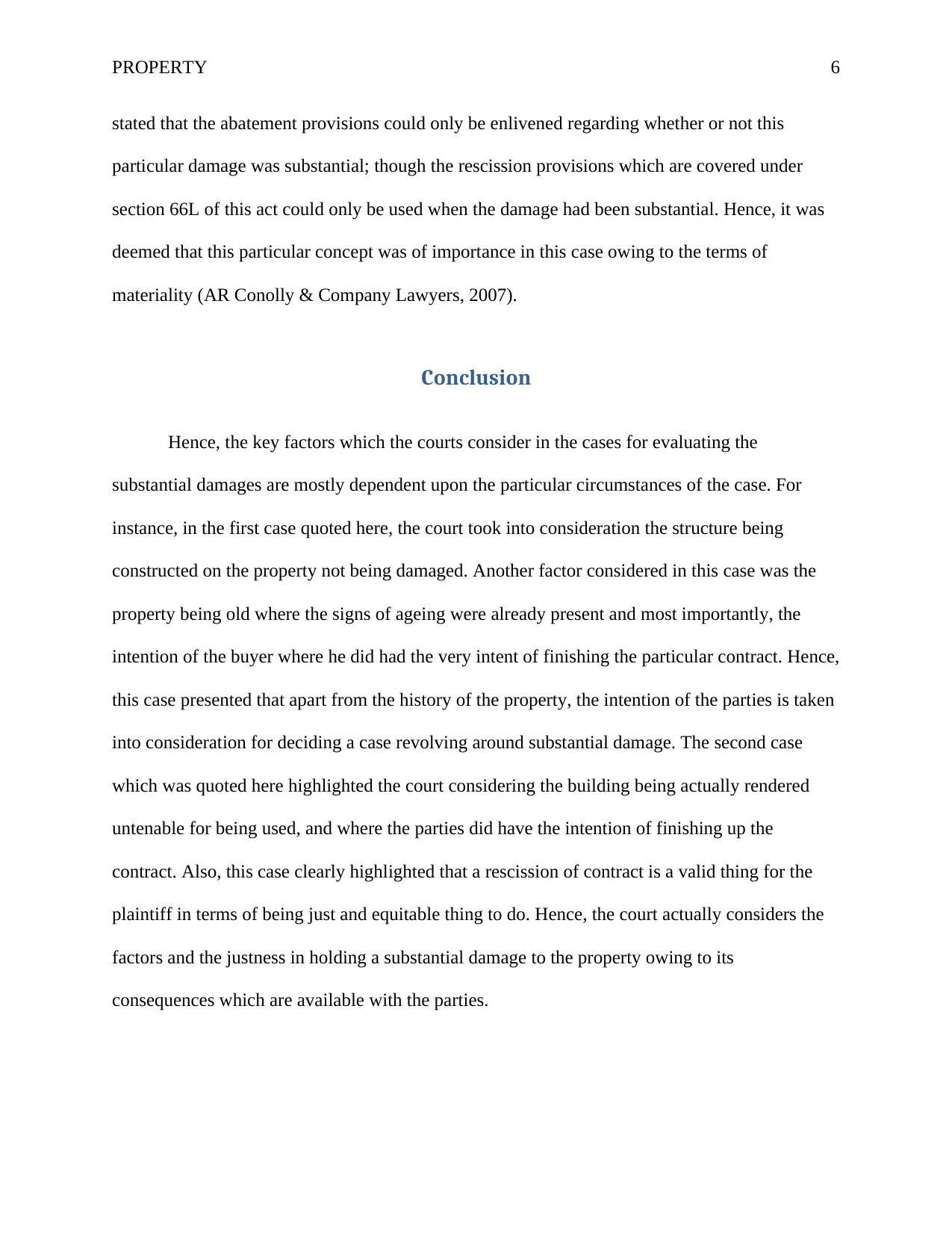
PROPERTY 6
stated that the abatement provisions could only be enlivened regarding whether or not this
particular damage was substantial; though the rescission provisions which are covered under
section 66L of this act could only be used when the damage had been substantial. Hence, it was
deemed that this particular concept was of importance in this case owing to the terms of
materiality (AR Conolly & Company Lawyers, 2007).
Conclusion
Hence, the key factors which the courts consider in the cases for evaluating the
substantial damages are mostly dependent upon the particular circumstances of the case. For
instance, in the first case quoted here, the court took into consideration the structure being
constructed on the property not being damaged. Another factor considered in this case was the
property being old where the signs of ageing were already present and most importantly, the
intention of the buyer where he did had the very intent of finishing the particular contract. Hence,
this case presented that apart from the history of the property, the intention of the parties is taken
into consideration for deciding a case revolving around substantial damage. The second case
which was quoted here highlighted the court considering the building being actually rendered
untenable for being used, and where the parties did have the intention of finishing up the
contract. Also, this case clearly highlighted that a rescission of contract is a valid thing for the
plaintiff in terms of being just and equitable thing to do. Hence, the court actually considers the
factors and the justness in holding a substantial damage to the property owing to its
consequences which are available with the parties.
stated that the abatement provisions could only be enlivened regarding whether or not this
particular damage was substantial; though the rescission provisions which are covered under
section 66L of this act could only be used when the damage had been substantial. Hence, it was
deemed that this particular concept was of importance in this case owing to the terms of
materiality (AR Conolly & Company Lawyers, 2007).
Conclusion
Hence, the key factors which the courts consider in the cases for evaluating the
substantial damages are mostly dependent upon the particular circumstances of the case. For
instance, in the first case quoted here, the court took into consideration the structure being
constructed on the property not being damaged. Another factor considered in this case was the
property being old where the signs of ageing were already present and most importantly, the
intention of the buyer where he did had the very intent of finishing the particular contract. Hence,
this case presented that apart from the history of the property, the intention of the parties is taken
into consideration for deciding a case revolving around substantial damage. The second case
which was quoted here highlighted the court considering the building being actually rendered
untenable for being used, and where the parties did have the intention of finishing up the
contract. Also, this case clearly highlighted that a rescission of contract is a valid thing for the
plaintiff in terms of being just and equitable thing to do. Hence, the court actually considers the
factors and the justness in holding a substantial damage to the property owing to its
consequences which are available with the parties.
⊘ This is a preview!⊘
Do you want full access?
Subscribe today to unlock all pages.

Trusted by 1+ million students worldwide
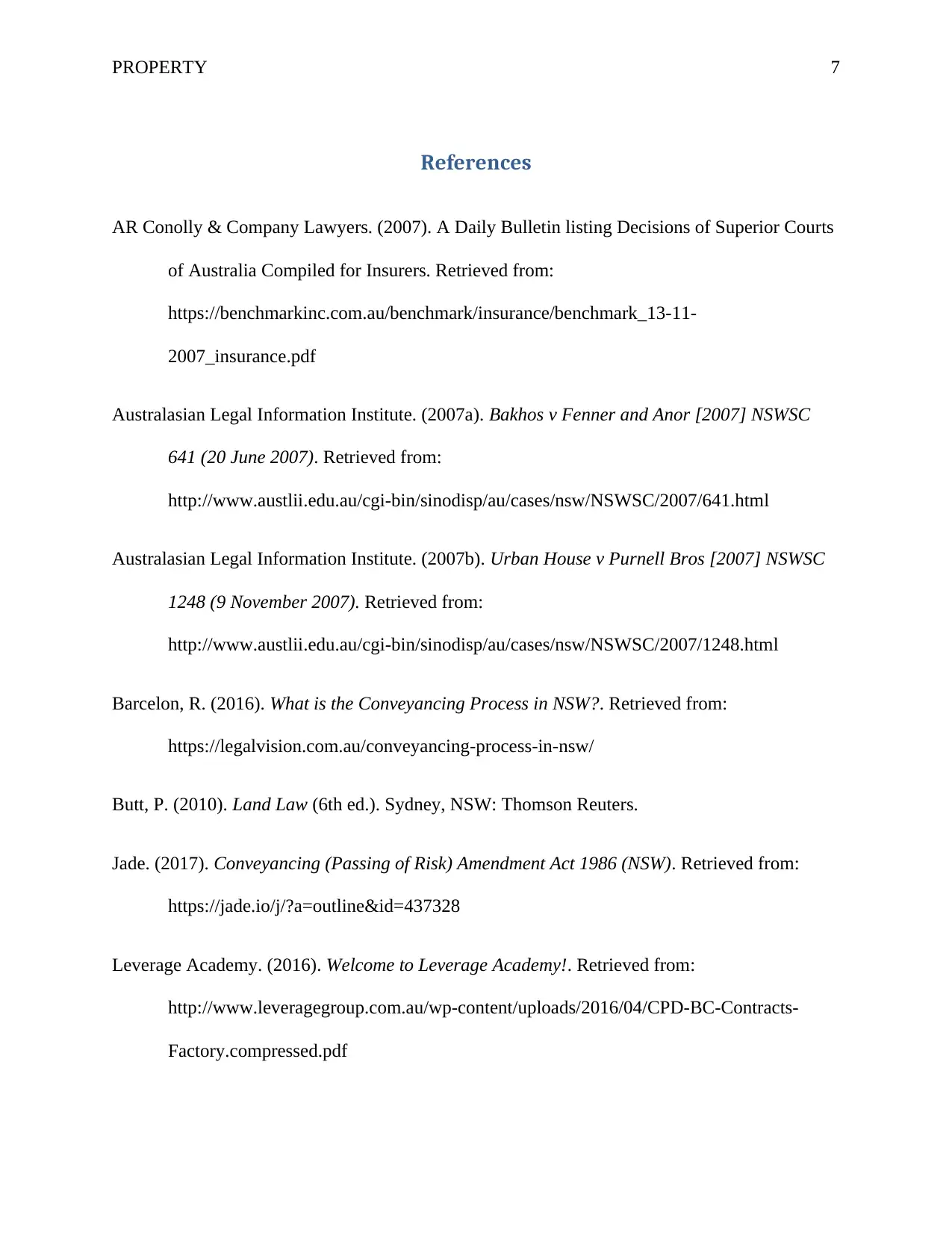
PROPERTY 7
References
AR Conolly & Company Lawyers. (2007). A Daily Bulletin listing Decisions of Superior Courts
of Australia Compiled for Insurers. Retrieved from:
https://benchmarkinc.com.au/benchmark/insurance/benchmark_13-11-
2007_insurance.pdf
Australasian Legal Information Institute. (2007a). Bakhos v Fenner and Anor [2007] NSWSC
641 (20 June 2007). Retrieved from:
http://www.austlii.edu.au/cgi-bin/sinodisp/au/cases/nsw/NSWSC/2007/641.html
Australasian Legal Information Institute. (2007b). Urban House v Purnell Bros [2007] NSWSC
1248 (9 November 2007). Retrieved from:
http://www.austlii.edu.au/cgi-bin/sinodisp/au/cases/nsw/NSWSC/2007/1248.html
Barcelon, R. (2016). What is the Conveyancing Process in NSW?. Retrieved from:
https://legalvision.com.au/conveyancing-process-in-nsw/
Butt, P. (2010). Land Law (6th ed.). Sydney, NSW: Thomson Reuters.
Jade. (2017). Conveyancing (Passing of Risk) Amendment Act 1986 (NSW). Retrieved from:
https://jade.io/j/?a=outline&id=437328
Leverage Academy. (2016). Welcome to Leverage Academy!. Retrieved from:
http://www.leveragegroup.com.au/wp-content/uploads/2016/04/CPD-BC-Contracts-
Factory.compressed.pdf
References
AR Conolly & Company Lawyers. (2007). A Daily Bulletin listing Decisions of Superior Courts
of Australia Compiled for Insurers. Retrieved from:
https://benchmarkinc.com.au/benchmark/insurance/benchmark_13-11-
2007_insurance.pdf
Australasian Legal Information Institute. (2007a). Bakhos v Fenner and Anor [2007] NSWSC
641 (20 June 2007). Retrieved from:
http://www.austlii.edu.au/cgi-bin/sinodisp/au/cases/nsw/NSWSC/2007/641.html
Australasian Legal Information Institute. (2007b). Urban House v Purnell Bros [2007] NSWSC
1248 (9 November 2007). Retrieved from:
http://www.austlii.edu.au/cgi-bin/sinodisp/au/cases/nsw/NSWSC/2007/1248.html
Barcelon, R. (2016). What is the Conveyancing Process in NSW?. Retrieved from:
https://legalvision.com.au/conveyancing-process-in-nsw/
Butt, P. (2010). Land Law (6th ed.). Sydney, NSW: Thomson Reuters.
Jade. (2017). Conveyancing (Passing of Risk) Amendment Act 1986 (NSW). Retrieved from:
https://jade.io/j/?a=outline&id=437328
Leverage Academy. (2016). Welcome to Leverage Academy!. Retrieved from:
http://www.leveragegroup.com.au/wp-content/uploads/2016/04/CPD-BC-Contracts-
Factory.compressed.pdf
Paraphrase This Document
Need a fresh take? Get an instant paraphrase of this document with our AI Paraphraser
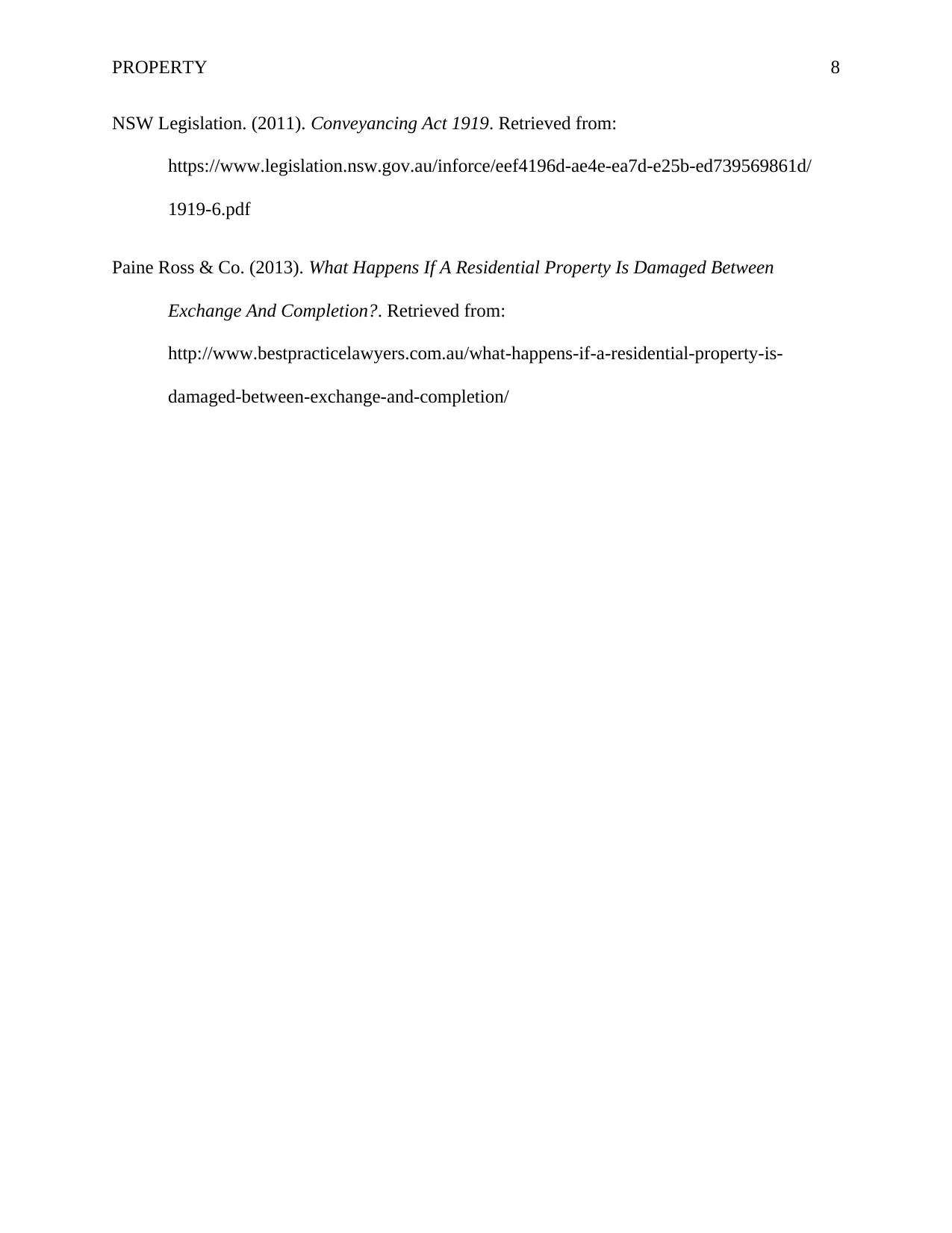
PROPERTY 8
NSW Legislation. (2011). Conveyancing Act 1919. Retrieved from:
https://www.legislation.nsw.gov.au/inforce/eef4196d-ae4e-ea7d-e25b-ed739569861d/
1919-6.pdf
Paine Ross & Co. (2013). What Happens If A Residential Property Is Damaged Between
Exchange And Completion?. Retrieved from:
http://www.bestpracticelawyers.com.au/what-happens-if-a-residential-property-is-
damaged-between-exchange-and-completion/
NSW Legislation. (2011). Conveyancing Act 1919. Retrieved from:
https://www.legislation.nsw.gov.au/inforce/eef4196d-ae4e-ea7d-e25b-ed739569861d/
1919-6.pdf
Paine Ross & Co. (2013). What Happens If A Residential Property Is Damaged Between
Exchange And Completion?. Retrieved from:
http://www.bestpracticelawyers.com.au/what-happens-if-a-residential-property-is-
damaged-between-exchange-and-completion/
1 out of 8
Related Documents
Your All-in-One AI-Powered Toolkit for Academic Success.
+13062052269
info@desklib.com
Available 24*7 on WhatsApp / Email
![[object Object]](/_next/static/media/star-bottom.7253800d.svg)
Unlock your academic potential
Copyright © 2020–2025 A2Z Services. All Rights Reserved. Developed and managed by ZUCOL.





